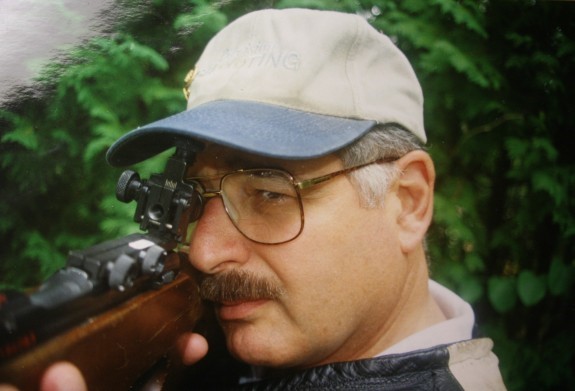Sitting on my bookshelf is a gift from the late great Art Jackson, two deformed metal discs. One is a 1947, the year I was born, Mexican one peso piece with a hole shot through it on the circumference, the other a lead disc with a bullet hole, just off center which has inscribed on it “Shot with a Remington Rifle” on one side and on the obverse, “Shot with a Remington Cartridge” with “Kleenbore” in it familiar dog bone shape in the center.
Art was given the pierced peso piece by Winchester’s legendary exhibition shooter Adolph Topperwein when he and Bill Blankenship visited him at his home in the early 1950s during a break from training for international competition at nearby Fort Bliss, Texas. Topperwein was long retired and the peso was taken from his store of coins he had shot when active. The lead slug was picked up following an exhibition shoot by Remington’s Tom Frye.
The first known exhibition shooter, Frank “Doc” Carver, won established a record by breaking 885 glass balls out of 1000 in San Francisco on February 22, 1878 and was proclaimed the “Champion Rifle Shot of the World.” Carver also laid down written rules for this now arcane branch of the shooting sports. The shooter could use any rifle shooting a solid bullet, the target had to be a 2 1.4 inch composition ball or wooden block, the assistants tossing the blocks had to stand between 25 and 30 feet in front of the shooter, the targets had to be thrown to a height between 25 and 30 feet, and a judge, referee, and scorer must be present at all times.
In December of 1907 Topperwein used three 1903 model Winchester .22 semiautomatic to shoot at 72,000 2½ inch square hand thrown wooden blocks, missing only nine. His longest run without a miss was 14,540 and followed the endurance shooting rules laid down by Carver, the father of the discipline.
On May 25, 1935, at Forbes Field, in Pittsburg, Pennsylvania, Babe Ruth his 712th, 713th, 714th homeruns. The 714th would be last he would hit, but it established a major league baseball career record for homers. Ruth started playing for the Boston Red Sox in 1914, played for the New York Yankees for 14 years after being sold by the Sox, and ended his days back in Boston with the cellar dwelling Bostin Braves in 1934. Ruth’s phenomenal career was fueled with natural talent he enhanced it with beer, broads and hot dogs and one minor run in with science
October of 1959 saw Remington’s Tom Frye, using three Remington Nylon 66 .22 semiautomatic rifles, hit 100,004 out of100,010 wooden over a period of 14 straight days. Breaking Topperwein’s record. Yet there was a cloud over his achievement in the bright Nevada sky when he finished.
Ruth’s record fell to Hammerin’ Hank Aaron when he hit his 715th home run on April 8, 1974 off of Los Angeles Dodgers pitcher Al Downing. The ball was caught in the bullpen by relief pitcher Tom House. It was a double connection with Ruth for he broke his record while wearing a Braves, albeit Atlanta, uniform. Aaron ended his career with 755 home runs, well before baseball’s Steroid Era.
Barry Bonds broke Aaron’s record on August 7, 2007, hitting a full-count, 84 mph pitch from Washington’s Mike Bacsik 435 feet to right-center field before a hometown crowd. It was a night game but even the bright lights of AT&T Park could not hide the cloud which hovered over the event.
To break any endurance record in shooting or baseball takes excellent physical conditioning, concentration, training, skill, the best equipment, patience, and resolve. For example, Frye’s Nylon 66 weighed four pounds and he lifted it 100,010 a total work out of a little over 20 tons, or about 1.5 tons a day for two straight weeks. Think of the friction on the trigger finger or the cumulative effect of the pounding of even the miniscule .22 Long Rifle cartridge, just 0.2 foot pounds, for that many shots.
Unfortunately, almost all of these record holding performances were soiled in some way or another. Carver was said to have taken morphine injections to ease the pain in his shoulder.
Ruth experimented once with an injection of sheep testicle extract to increase his power but it instead it made him violently ill, giving a whole new meaning to the term foul ball. His time on the Disabled List was chalked off by the Yankee front office as one of his famous hot dog induced belly aches.
Frye was reported to have taken muscle relaxants to ease him through his marathon and he did not abide by Carver’s rules. The noted forearms writer crusty Colonel Charles Askins had examined photos of Frye’s attempt and noted that the man tossing the blocks was standing just off Frye’s left shoulder, a more advantageous position than Topperwein.
Topperwein’s only relief for his sore muscles was having his wife Plinky help him dress and occasionally bathe his face with cool water during shooting while a barber shaved him each morning.
The amiable Aaron was known to take an occasional beer after a game in the locker room with his teammates to relax while the abrasive and standoffish Bonds was a central figure in Major League Baseball’s performance enhancing drug scandal.
Never the less, each man’s singular accomplishment, some tainted, represents, as Topperwein put it to Frye, an accomplishment of “wonderful endurance and accuracy.”
Impressive as they were what about the wonderful endurance and accuracy of the anonymous men who rhythmically tossed thousands of wooden blocks 25 to 30 feet into the air for days on end?




